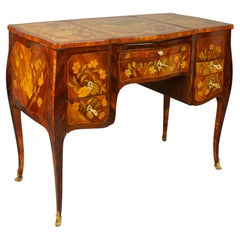All Trophy Bottle Set
Recent Sales
Antique 1750s French Louis XV Vanities
Iron, Tin, Silver
A Close Look at louis-xv Furniture
The style of 18th-century French furniture was guided by the court. When Louis XV, who reigned from 1715–74, focused royal life on the smaller salons of Versailles rather than its grand chambers, it transformed the aesthetics away from the imposing and angular furniture that characterized the style of Louis XIV. A broader focus on comfort and more delicate forms define antique Louis XV furniture, with nature-inspired carvings, wood inlays, curved cabriole legs, asymmetrical shapes and rounded oval seat backs. The furnishings changed throughout the king’s life, as he ascended to the throne as a child and then grew to establish his own tastes.
Pieces like the bergère, an upholstered armchair with a wide cushion that fit the flowing dresses in fashion at the time, reflected this more informal court. Introduced at the start of Louis XV’s reign, bergère chairs in this style were deeper and broader than other chairs of the period.
Louis XV tapestries and carpets tended to be floral and colorful, and design elements were borrowed from Asia. Dutch-born cabinetmaker Bernard van Risenburgh brought lacquer techniques influenced by Japan and China into his luxuriously made furniture. Along with its fine details, the furniture of the era also featured new innovations including mechanical devices. Jean François Oeben, a royal cabinetmaker, created such intricate pieces as a mechanical table for Madame de Pompadour, Louis XV’s mistress. It involved a sliding top and a writing surface that extended from its marquetry panels.
During the later years of Louis XV’s reign, there was a shift from the ostentatious rocaille style, part of the exuberantly decorative Rococo movement in Europe for which designers such as Nicolas Pineau and Juste-Aurèle Meissonier are known. The style under Louis XVI would return to boxier forms, but with a neoclassical touch inspired by the ancient world.
Find antique Louis XV bedroom furniture, seating, tables and decorative objects on 1stDibs.
Finding the Right desks-writing-tables for You
Choosing the perfect writing desk or writing table is a profoundly personal journey, one that people have been embarking upon for centuries.
Queen Atossa of Persia, from her writing table circa 500 B.C., is said to have been the originator of the art of handwritten letters. Hers was reportedly the first in a long and colorful history of penned correspondence that grew in popularity alongside literacy. The demand for suitable writing desks, which would serve the composer of the letters as well as ensure the comfort of the recipient naturally followed, and the design of these necessary furnishings has evolved throughout history.
Once people began to seek freedom from the outwardly ornate styles of the walnut and rosewood writing desks and drafting tables introduced in the name of Queen Victoria and King Louis XV, radical shifts occurred, such as those that materialized during the Art Nouveau period, when designers longed to produce furniture inspired by the natural world’s beauty. A prime example is the work of the famous late-19th-century Spanish architect Antoni Gaudí — his rolltop desk featured deep side drawers and was adorned with carved motifs that paid tribute to nature. Gaudí regularly combined structural precision with decorative elements, creating beautiful pieces of furniture in wood and metal.
Soon afterward, preferences for sleek, geometric, stylized forms in furniture that saw an emphasis on natural wood grains and traditional craftsmanship took hold. Today, Art Deco desks are still favored by designers who seek to infuse interiors with an air of luxury. One of the most prominent figures of the Art Deco movement was French decorator and furniture designer Émile-Jacques Ruhlmann. With his use of neoclassical motifs as well as expensive and exotic materials such as imported dark woods and inlays of precious metals for his writing desks, Ruhlmann came to symbolize good taste and modernity.
The rise in appreciation for Scandinavian modernism continues to influence the design of contemporary writing desks. It employs the “no fuss” or “less is more” approach to creating a tasteful, sophisticated space. Sweden’s master cabinetmaker Bruno Mathsson created gallery-worthy designs that are as functional as they are beautiful. Finnish architect Alvar Aalto never viewed himself as an artist, but, like Mathsson, his furniture designs reflected a fondness for organic materials and a humanistic approach. Danish designers such as Hans Wegner introduced elegant shapes and lines to mid-century desks and writing tables, often working in oak and solid teak.
From vintage desks to contemporary styles, 1stDibs offers a broad spectrum of choices for conducting all personal and business writing and reading activities.
